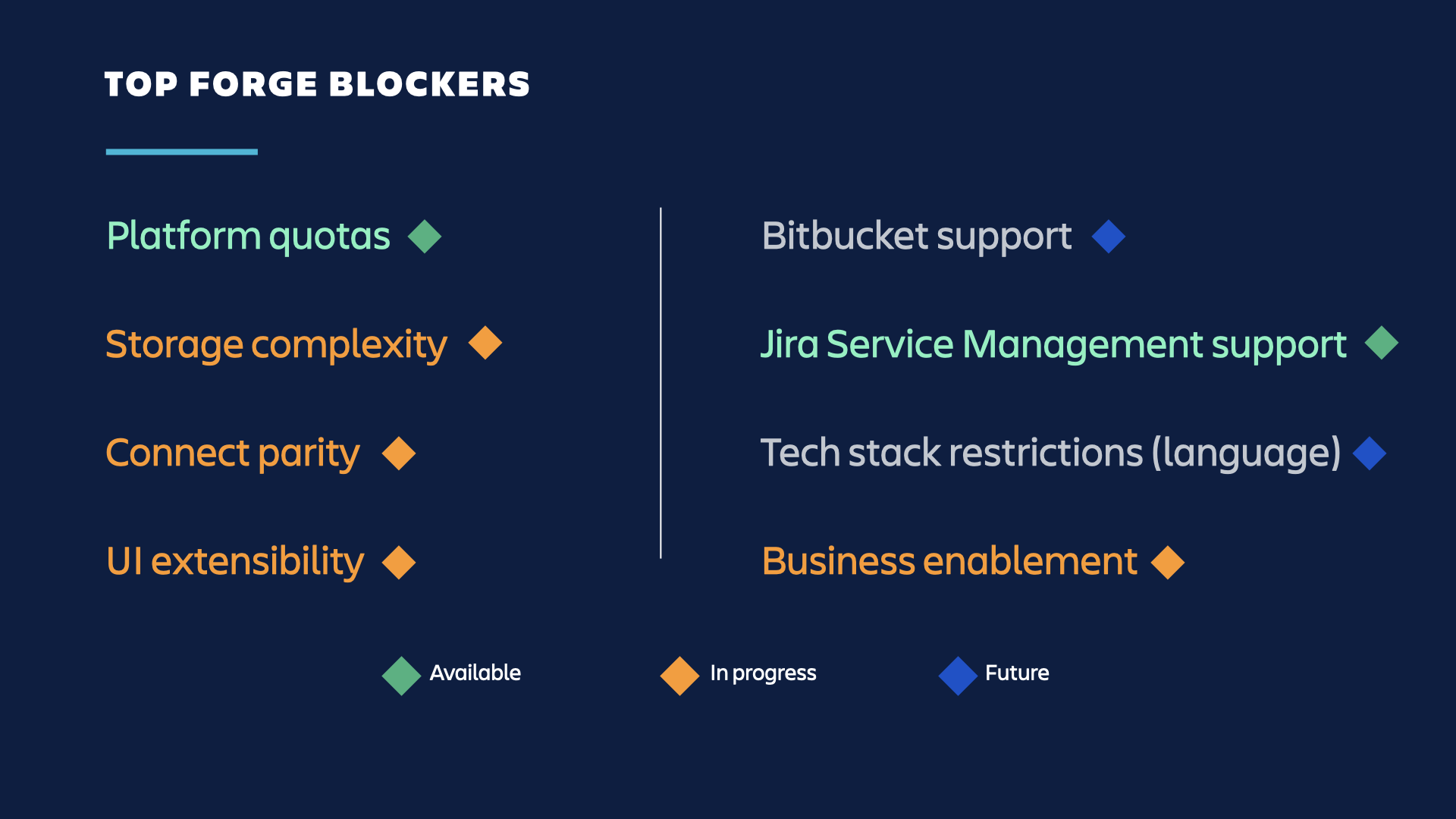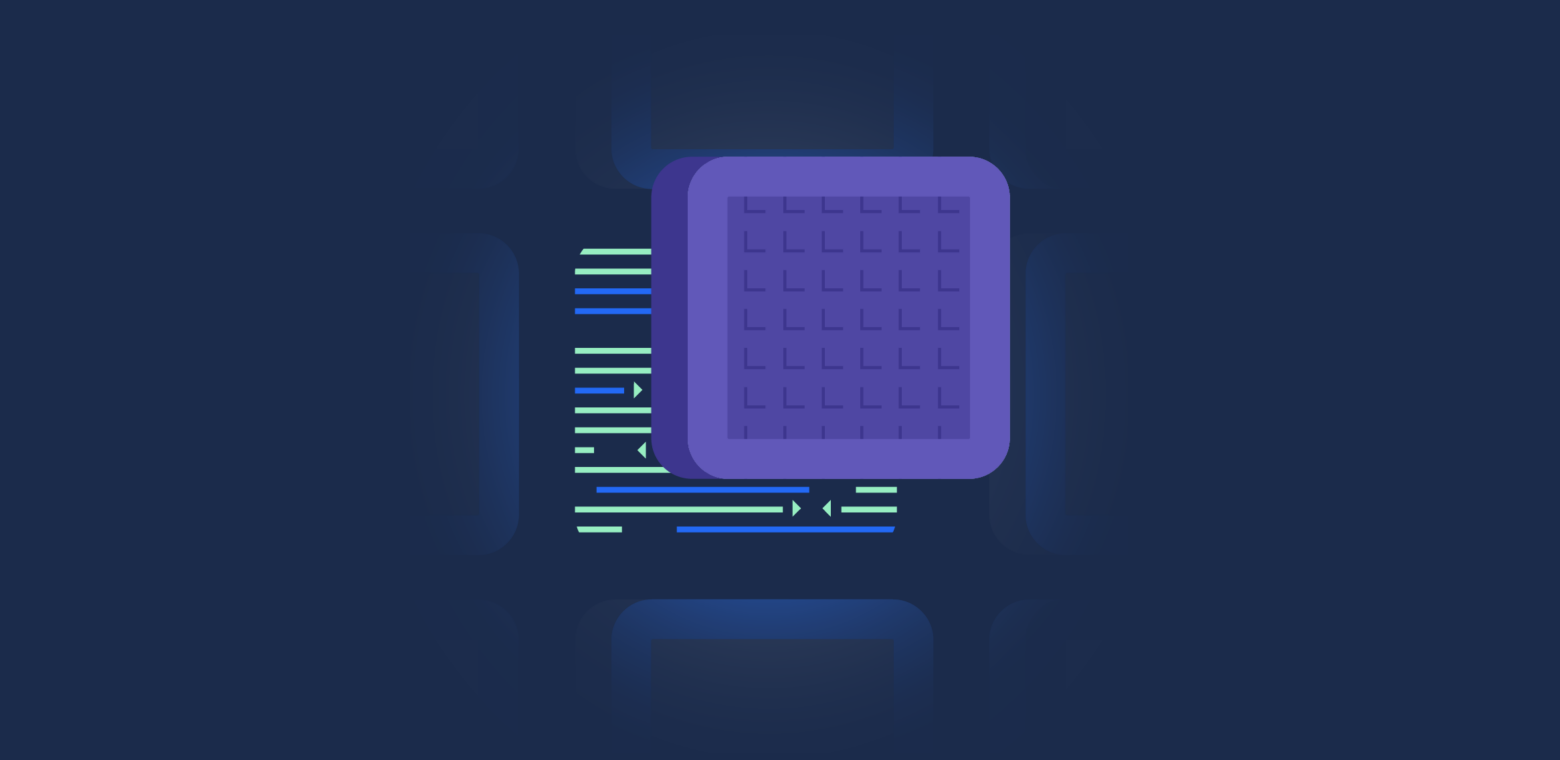Since our last Forge webinar in November, we’ve made more exciting progress. Forge continues to gain momentum: since Forge reached general availability in May 2021, over 5,600 apps have been built on the platform.
And we’ve made progress toward removing some of the blockers preventing developers from building on Forge. At the end of last year, we surveyed partners about the barriers they faced to building on Forge. During the Q1 webinar, we shared an update on where we are with those blockers today.

We also made a few exciting announcements about new Forge features and what’s coming soon. Read on for a quick summary of the webinar, plus a recap of key questions from our Q&A session.
Recently shipped
This month, shared progress on extending Forge across the full Atlassian product suite, including Jira Service Management – available now. We also discussed lifting Forge storage quotas and adding new Forge extension points for Jira.
Forge now supports Jira Service Management
Developers can now build apps for Jira Service Management using Forge. This release includes Forge-compatible REST APIs for Jira Service Management and 8 UI extension points, including the agent view, the customer portal, and the request view. Both paid and free Forge apps for Jira Service Management can be listed in the Marketplace.
Stay tuned for more enhancements coming soon, including the ability for users to make portal service requests without needing an Atlassian account. For more details, read the announcement on the blog.
Introducing Compass
Compass is a new Atlassian product – a developer experience platform that helps you navigate your distributed architecture, bringing disconnected information together in a central, searchable location. We’ve considered extensibility from day one, and we’ve added Compass-specific UI extension points and a runtime SDK for accessing the Compass GraphQL API. Learn more about building apps for Compass.
Higher Forge storage limits
We want you to be able to focus on functionality and less on staying within platform limits, so we’ve made a few recent changes.
These updates include:
- Doubling storage base quotas to support large installations
- Doubling the right operation limits
- Increased quota for secret storage API
- Increased API key length and value size
- Increased compute runtime for all Forge modules from 10 seconds to 25 seconds
For more information on storage and limits, check out the documentation, and reach out via the Developer Service Desk if you think your app may exceed the new limits.
New Jira extension points
We’ve added several new extension points for Jira and announced several which are coming soon. These additional extension points will help expand what your app can do in Jira and where it can do it.
Shipped
Custom fields on Create Issue View: You can now render Forge custom fields on the create issue view, and use UI kit or formatter to define how your field will look.
Custom Field Improvements: We’ve added a formatter, a new data type for date/time, and a new Jira event for custom fields.
Jira Project Setting Page: You can now extend the project settings page and build features dedicated for project admins, adding an item to the project settings sidebar, and more.
Jira Global Page: Adds an item to the Apps section in the top navigation toolbar
Coming soon
Jira Entity Properties: You can now define Jira entity properties searchable within JQL. FRGE-158
Dashboards: Users can add Forge dashboard gadgets. FRGE-207
Jira subPages: Build more complex apps using subPages. FRGE-509
Custom field Improvements: We’ve added in-line edit on create issues view and more custom field additions. FRGE-609
Issue adjustments: A real game changer! Users can now change how Jira native fields behave. FRGE-608
Modals: Open the Issue View and create new Issue View modals. FRGE-494
Refresh issue view: Show real time data on the Issue View. FRGE-177
We’re excited to see what you build with them!
New granular scopes
Previously, Forge offered 10-12 scopes. As of February 23rd, we’re moving towards having 70. Updating your app scopes ensures you’re taking the necessary steps to protect your customer’s data and adhere to security requirements. Join the conversation in the developer community for more info on important dates and FAQs.
Forge app monitoring
Forge App Monitoring has shipped, offering new insights into the ongoing performance of your Forge apps. You can now track metrics, including overall app health and function error count.
Feedback from Forge developers is helping us prioritize which metrics to include next. A few of the things coming soon include filtering metrics, grouping metrics, basic alerting, and more functions that provide more visibility into app performance.
UI kit out of beta
Great news – UI Kit is now generally available. UI kit offers a range of options for simpler interfaces, making it easier to build intuitive experiences. And version 1.0 isn’t the end. We still have more big ideas about how it can grow and fit new use cases.
What’s Next on Forge?
Here are a few things we’re working on this year.
Automation for Forge
We’re working on opening up the power of Automation to Marketplace partners, so you can enhance your apps with custom actions and conditions. Additionally, you’ll be able to ship rule templates to simplify setup for administrators.
Bitbucket for Forge
We’re thrilled to announce that we’re planning to bring Bitbucket to Forge, so developers can have a single platform for cloud development. We’re still early in the process, but the road ahead holds so many possibilities.
Workflows Extensibility
We plan to extend Forge to allow developers to define workflow conditions based on Jira expressions. App builders will also be able to specify the UI point and use saved configurations. And finally, we’ll be working on workflow conditions, workflow validators, and workflow post functions.
Custom UI improvements
We’re also working on enhancements to the Custom UI Bridge to better enable Custom UI apps to integrate with Atlassian products, as well as building functional parity with Connect.
Q&A
At the end of the webinar, we took questions from the audience. Here are a few of the highlights.
What is the process to request an increase to storage limits?
If you’d like to request a custom storage limit, you can raise a ticket through the developer service desk with the details of the app, storage limit, and use case for this requirement. The Atlassian Team will review your request and get back to you.
Do you have plans to support inline macros for Confluence?
Definitely! It’s our top voted request. We’re currently working with the team to build a timeline.
When will Forge support teams developing apps allowing for multiple owners of an app?
This is a feature we call “multi-user app ownership”, and it’s one of our top priorities. We hope to launch it at the end of 2022 or early 2023.
What is Atlassian doing to assist and support general response time?
We are spending a lot of time on our support structure. We want to make sure our content is top shelf, so you can use self service. We’re also extending our development experience team so you can get answers quickly. Our team has a strong focus on reliability and support for this year.
Can Compass apps be sold on the Marketplace?
This is currently not possible, since the Compass team has to integrate with the Marketplace. It’s on the roadmap for the future.
Until next time
Thank you to everyone who joined us for this quarter’s webinar! If you’d like to watch the replay in full, you can do on the Atlassian Developer YouTube channel.
Next quarter, we’ll be back with more Forge product updates, but we’re offering something slightly different for Q2 instead of our usual webinar. On June 9, we’re hosting Developer Day 2022 – a virtual event celebrating the community of builders that make up the Atlassian ecosystem. In addition to talks from Atlassians and community members, we’ll cover product news and announcements – so stay tuned, registration will open soon.

